Advertisements
Advertisements
प्रश्न
What are the two methods for obtaining coherent sources in the laboratory?
उत्तर
In the laboratory, coherent sources can be obtained by using (1) Lloyd's mirror and (2) Fresnel's biprism.
- Lloyd's mirror:
This is an extensively used device. The light from a source is made to fall at a grazing angle on a plane mirror as shown in figure.
Some of the light falls directly on the screen as shown by the blue lines in the figure and some light falls after reflection, as shown by the red lines. The reflected light appears to come from a virtual source and so we get two sources. They are derived from a single source and hence are coherent. They interfere and an interference pattern is obtained as shown in the figure. Note that even though we have shown the direct and reflected rays by blue and red lines, the light is monochromatic having a single wavelength. - Fresnel's biprism:
A biprism is a prism with a vertex angle of nearly 180°. It can be considered to be made up of two prisms with very small refracting angle ranging from 30′ to 1°, joined at their bases. In experimental arrangement, the refracting edge of the biprism is kept parallel to the length of the slit. Monochromatic light from a source is made to pass through a narrow slit S as shown in Figure and fall on the biprism.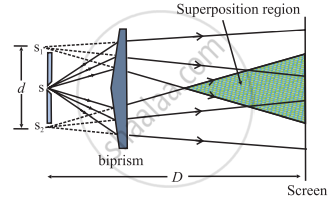
The two halves of the biprism form virtual images S1 and S2. These are coherent sources having obtained from a single secondary source S. The two waves coming from S1 and S2 interfere and form interference fringes like that in Young’s double-slit experiment in the shaded region shown in the figure.
APPEARS IN
संबंधित प्रश्न
When a drop of oil is spread on a water surface, it displays beautiful colours in daylight because of ______________ .
In Young’s double slit experiment, the slits are separated by 0.5 mm and screen is placed 1.0 m away from the slit. It is found that the 5th bright fringe is at a distance of 4.13 mm from the 2nd dark fringe. Find the wavelength of light used.
Why are multiple colours observed over a thin film of oil floating on water? Explain with the help of a diagram.
Answer in brief:
Explain what is the optical path length. How is it different from actual path length?
Two coherent sources whose intensity ratio is 25:1 produce interference fringes. Calculate the ratio of amplitudes of light waves coming from them.
Why two light sources must be of equal intensity to obtain a well-defined interference pattern?
What is interference?
One of Young’s double slits is covered with a glass plate as shown in figure. The position of central maximum will,
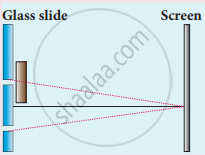
Obtain the relation between phase difference and path difference.
How do source and images behave as coherent sources?
Explain Young’s double-slit experimental setup and obtain the equation for path difference.
Two independent monochromatic sources cannot act as coherent sources, why?
Does diffraction take place at Young’s double-slit?
In Young’s double-slit experiment, 62 fringes are seen in the visible region for sodium light of wavelength 5893 Å. If violet light of wavelength 4359 Å is used in place of sodium light, then what is the number of fringes seen?
The ratio of maximum and minimum intensities in an interference pattern is 36 : 1. What is the ratio of the amplitudes of the two interfering waves?
A graph is plotted between the fringe-width Z and the distance D between the slit and eye-piece, keeping other adjustment same. The correct graph is
A.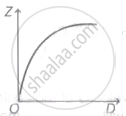 |
B.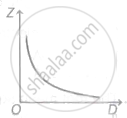 |
C. |
D.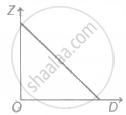 |
Two identical light waves having phase difference 'Φ' propagate in same direction. When they superpose, the intensity of the resultant wave is proportional to ______.
In Young's double-slit experiment, an interference pattern is obtained on a screen by a light of wavelength 4000 Å, coming from the coherent sources S1 and S2 At certain point P on the screen, third dark fringe is formed. Then the path difference S1P - S2P in microns is ______.
Two coherent light sources of intensity ratio 'n' are employed in an interference experiment. The ratio of the intensities of the maxima and minima in the interference pattern is (I1 > I2).
In biprism experiment, if the 5th bright band with wavelength 'λ1' coincides with the 6th dark band with wavelength 'λ2' then the ratio `(lambda_2/lambda_1)` is ______
The graph shows the variation of fringe width (β) versus distance of the screen from the plane of the slits (D) in Young's double-slit experiment Keeping other parameters the same. The wavelength of light used can be calculated as d = distance between the slits ______
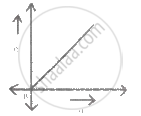
In a biprism experiment, monochromatic light of wavelength (λ) is used. The distance between two coherent sources is kept constant. If the distance between slit and eyepiece (D) is varied as D1, D2, D3, and D4, the corresponding measured fringe widths are z1, z2, z3, and z4 then ______
In Young's double slit experiment, for wavelength λ1 the nth bright fringe is obtained at a point P on the screen. Keeping the same setting, source of light is replaced by wavelength λ2 and now (n + 1)th bright fringe is obtained at the same point P on the screen. The value of n is ______.
Young's double slit experiment is performed in water, instead of air, then fringe width ______.
Two waves with same amplitude and frequency superpose at a point. The ratio of resultant intensities when they arrive in phase to that when they arrive 90° out of phase is ______.
`[cos pi/2=0]`
In Young's double-slit experiment, the distance between the slits is 3 mm and the slits are 2 m away from the screen. Two interference patterns can be obtained on the screen due to light of wavelength 480 nm and 600 run respectively. The separation on the screen between the 5th order bright fringes on the two interference patterns is ______
What is meant by Constructive interference?
A beam of electrons is used in Young's double-slit experiment. If the speed of electrons is increased then the fringe width will ______.
The interference pattern is obtained with two coherent light sources of intensity ratio 4 : 1. And the ratio `("I"_"max" - "I"_"min")/("I"_"max" + "I"_"min")` is `5/x`. Then the value of x will be equal to ______.
